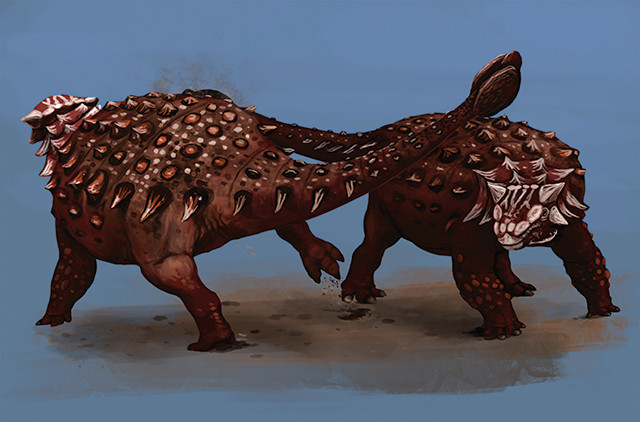
by Lucas Joel Tuesday, April 10, 2018

New research finds that extinct, tail weapon-wielding animals — such as the dueling ankylosaurs illustrated here — all shared a set of traits, including large body size, herbivory and bony body armor, that no modern animals possess. Credit: Jack Mayer Wood.
Stegosaurus wielded a spiked tail — dubbed a “thagomizer” by cartoonist Gary Larson and informally adopted by paleontologists — which the herbivorous dinosaur likely used for defense against hungry predators. Other extinct animals also sported foe-clobbering tail weapons: Ankylosaurus had a tail club, as did extinct mammals like the glyptodonts, giant armadillo-like animals that once roamed the Americas. Today, though, thagomizers and bony tail clubs are things of the past. In a new study, paleontologists have found that extinct animals with such weapons all shared a now-antiquated set of traits: They were large, herbivorous, and had body armor and a stiff torso.
This cocktail of characteristics does not exist in any living animal, says Victoria Arbour, a vertebrate paleontologist at the Royal Ontario Museum in Toronto, Canada, who led the new research, published in Proceedings of the Royal Society B. Other weapons, like those that adorn the heads of many ancient and living animals, appear to be commonplace, while tail weapons are rare. “We wanted to dig into why that might be,” Arbour says.
Teaming with Lindsay Zanno, a vertebrate paleontologist at the North Carolina Museum of Natural Sciences and co-author of the new study, Arbour studied the evolution of tail weapons by examining 286 diverse taxa, some of which had weaponized tails and some of which did not, including turtles, bison and long-necked, long-tailed sauropod dinosaurs, among others. “Using phylogenetic comparative methods lets us test for statistical significance in trait correlations” among taxa, Arbour says. From the researchers’ analysis, large body size and herbivory correlated most strongly with possession of tail weaponry, shedding light on the absence of such weapons in smaller herbivores. “Several small lizards today [like the spiny-tailed lizard] use spiky tails as defensive weapons, but elaborate bony tails were more likely to evolve in large herbivores,” she says. Bony body armor is another trait that co-occurred with tail weapons in Arbour and Zanno’s analysis.
This is the first research to test questions about the evolution of tail weapons in a quantitative way, says Susie Maidment, a vertebrate paleontologist at the Natural History Museum in London who was not involved in the work. “The study doesn’t state that all of the requirements the authors identify have to be met for weaponry to evolve; it simply shows correlations between specific traits and weaponry,” Maidment says. However, she says, body armor was likely a necessary precursor to the evolution of tail weapons. In some animals, this armor allowed for “a more active form of defense at the end of the tail.” The results suggest that animals that evolved bony tail weaponry had to be “pre-adapted to do so,” she says, noting that along with body armor, a stiff body — which would have helped animals brace themselves against the forces generated by swinging their tails — may have been a necessary pre-adaptation.
Tail weapons seem to have disappeared about 10,000 years ago with the extinction of the glyptodonts. Large modern herbivores may lack tail weapons for defense in part because the selective pressure that led to the weapons’ evolution in the older taxa eventually subsided as other defensive strategies emerged, like the ability to outrun predators or traveling in herds.
One remaining mystery is why tail weapons did not emerge in carnivores. While Arbour and Zanno did not directly address carnivores in their research, Arbour says that carnivores may not have bony tail weapons because they already have enough armament in the form of sharp teeth or claws, or other adaptations. Even so, she points out that some modern carnivores do in fact use their tails as weapons: “Monitor lizards will whip their tails to deter predators, even though they are predators themselves,” she says. “There’s a lot to learn about this unusual behavior in living animals.”
© 2008-2021. All rights reserved. Any copying, redistribution or retransmission of any of the contents of this service without the expressed written permission of the American Geosciences Institute is expressly prohibited. Click here for all copyright requests.